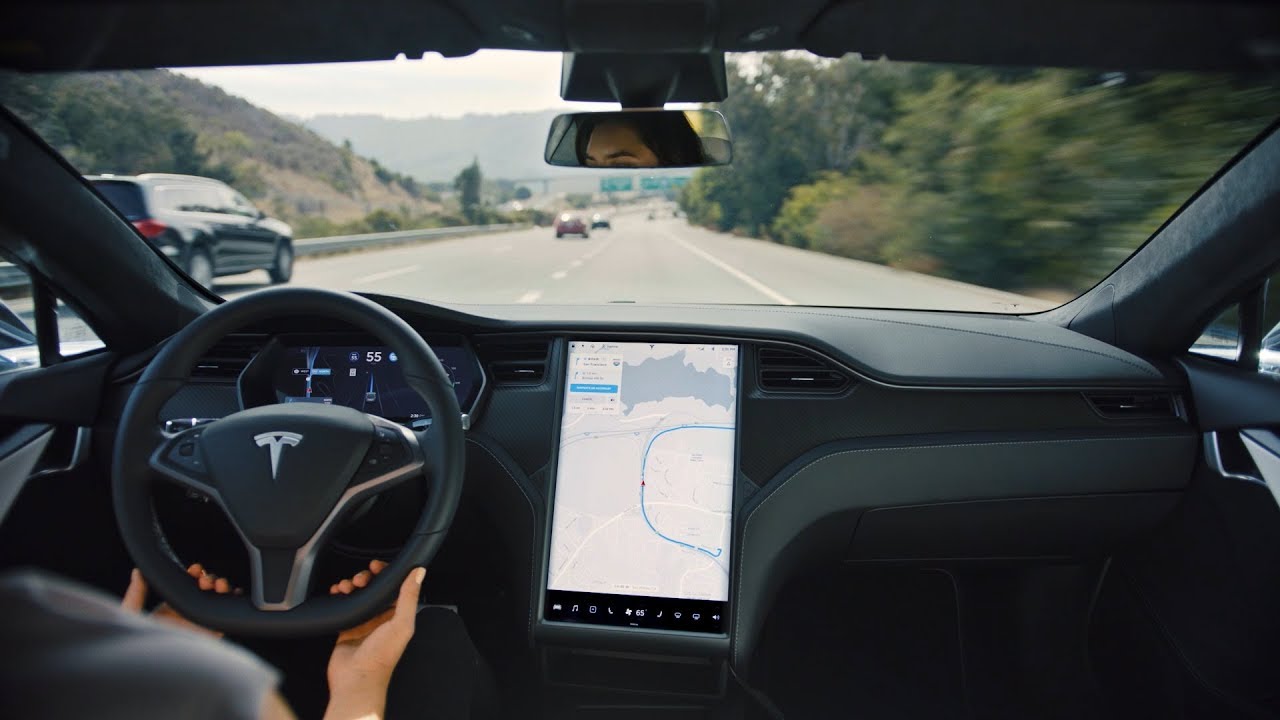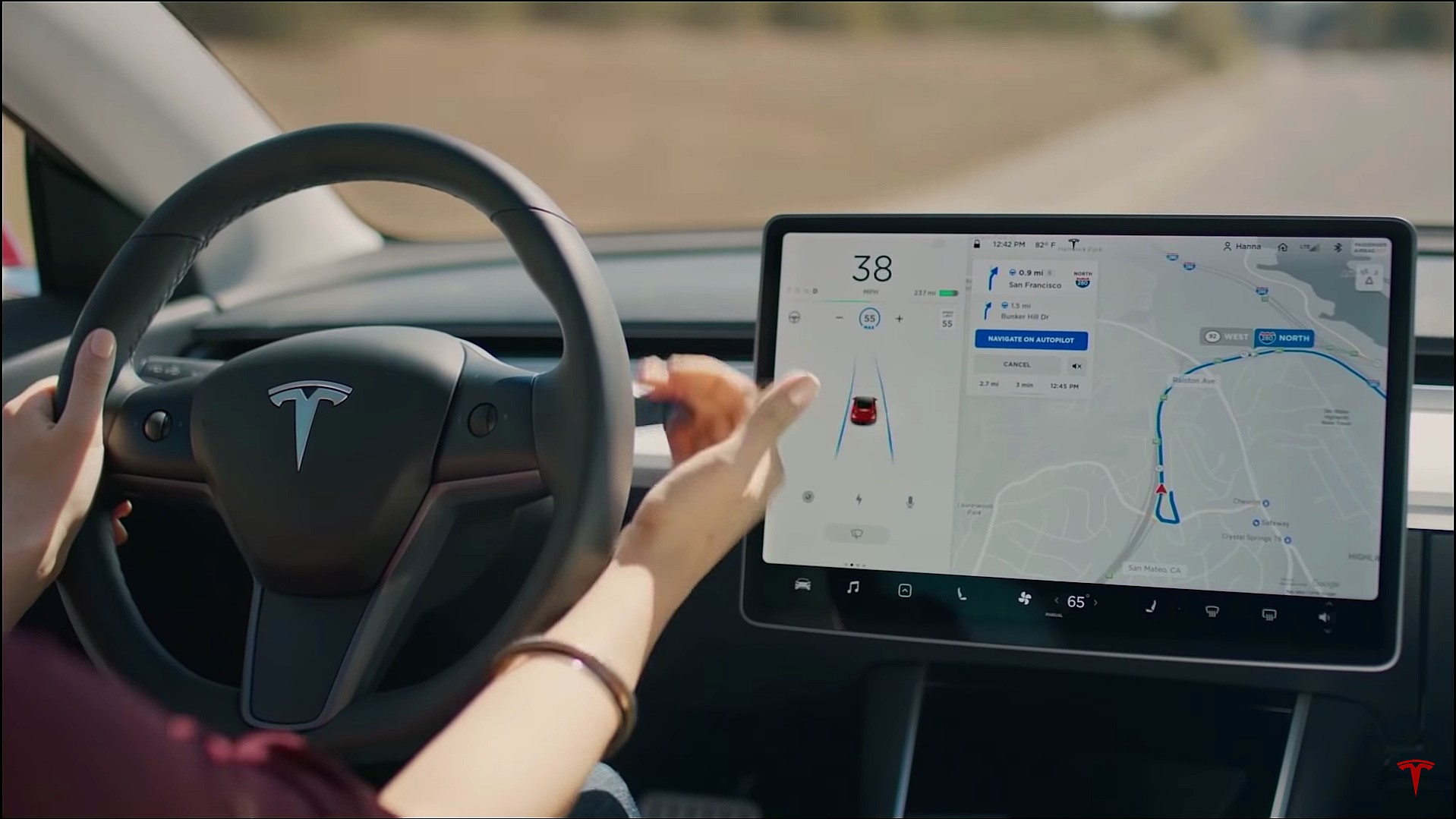The Insurance Institute for Highway Safety (IIHS) tested Tesla Autopilot safeguards and found that drivers are pretty quick to adapt to the windows of opportunity the suite gives after warning them to pay attention.
The IIHS study sought to determine whether partially automated driving systems and their safeguards increase driver attentiveness. With the rollout of more advanced driver assistance systems (ADAS) and semi-autonomous driving functionalities, the goal is to increase safety.
However, these suites still require the driver to pay attention and be aware of any potential opportunity to take over if needed. These driving systems and features are designed to increase safety but still require the driver’s full attention, hence their semi-autonomous label.
Credit: Tesla
For the study, the IIHS tested both Tesla Autopilot safeguards and those available in Volvo’s Pilot Assist.
The study gave 14 drivers a month with a 2020 Tesla Model 3 and required them to travel on Autopilot, when available, over one month. The IIHS wanted to see how drivers behaved leading up to, during, and after attention reminders prompted by a lack of focus on their end.
The Autopilot study found that drivers could learn safeguard sequences and identify “windows of opportunity” to perform non-driving-related tasks. These vehicles still utilized an Autopilot nag and a torque sensor to monitor whether the driver was paying attention. Failure to keep hands on the steering wheel would result in attention reminders.
Failure to change after the reminders would result in suspension of the Autopilot system, commonly referred to as “Autopilot jail.”
The study found:
“In total, the volunteers drove a little more than 12,000 miles with Autopilot engaged. During that time, they triggered 3,858 attention-related warnings from the partial automation system. About half of those alerts occurred when they had at least one hand on the steering wheel but were apparently not moving it enough to satisfy the torque sensor.”
Most warnings did not go past the initial reminder, and only 72 instances resulted in the driver not responding fast enough to prevent the alerts from escalating.
The study found that while initial warnings increased by 26 percent over the first four weeks, showing drivers were prone to expect it, escalations fell by 64 percent, meaning they did not allow the system to continue warning them.
However, this does not mean that non-driving secondary activities stopped after the first warning. Instead, the study showed something interesting:
“The researchers found that the drivers did nondriving secondary activities, looked away from the road, and had both hands off the wheel more often during the alerts and in the 10 seconds before and after them as they learned how the attention reminders worked. The longer they used the system, the less time it took them to take their hands off the wheel again once the alerts stopped.”
The IIHS admits that the safety impact of the change is hard to measure. While the agency noted that some research shows the longer a driver allows their attention to wander, the more likely they will be involved in an accident, the study also said that “even short lapses of attention become so frequent that the periods of supposed engagement between them have little value.”
The study also said the safeguards can be beneficial to behavior immediately and in the longer term, and other patterns showed potentially unintended consequences:
“The current study has shown that driver interactions with partial automation are dynamic. Some of the changes we observed indicate that system safeguards can beneficially shape behavior both immediately and in the longer term, whereas other patterns revealed potentially unintended consequences. It is important to note that these findings are likely not unique to Tesla’s Autopilot, as many systems on the market have overtly similar safeguard designs. As such, some observations from this study maybe relevant to other driver assistance technology that still requires the driver to be engaged in the driving task.”
IIHS Senior Research Scientist Alexandra Mueller, who led the study, said:
“These results show that escalating, multimodal attention reminders are very effective in getting drivers to change their behavior. However, better safeguards are needed to ensure that the behavior change actually translates to more attentive driving.”
While this study provides evidence that perhaps better safeguards are needed, it is important to note that Tesla has upgraded the in-cabin camera to monitor driver attentiveness.
Tesla activates cabin-facing camera in bid to improve vehicle safety
Additionally, many cars are on the road without these driver assistance and safety features.
Distracted driving is going to occur whether a vehicle is equipped with modern technology or not.
Tesla and other automakers have brought their newest vehicles up to speed in the fight against distracted driving, and perhaps this study showed that warnings could and should come at varying rates to prevent anticipation from drivers.
I’d love to hear from you! If you have any comments, concerns, or questions, please email me at joey@teslarati.com. You can also reach me on Twitter @KlenderJoey, or if you have news tips, you can email us at tips@teslarati.com.

Elon Musk
Elon Musk and Tesla AI Director share insights after empty driver seat Robotaxi rides
The executives’ unoccupied tests hint at the rapid progress of Tesla’s unsupervised Robotaxi efforts.

Tesla CEO Elon Musk and AI Director Ashok Elluswamy celebrated Christmas Eve by sharing personal experiences with Robotaxi vehicles that had no safety monitor or occupant in the driver’s seat. Musk described the system’s “perfect driving” around Austin, while Elluswamy posted video from the back seat, calling it “an amazing experience.”
The executives’ unoccupied tests hint at the rapid progress of Tesla’s unsupervised Robotaxi efforts.
Elon and Ashok’s firsthand Robotaxi insights
Prior to Musk and the Tesla AI Director’s posts, sightings of unmanned Teslas navigating public roads were widely shared on social media. One such vehicle was spotted in Austin, Texas, which Elon Musk acknowleged by stating that “Testing is underway with no occupants in the car.”
Based on his Christmas Eve post, Musk seemed to have tested an unmanned Tesla himself. “A Tesla with no safety monitor in the car and me sitting in the passenger seat took me all around Austin on Sunday with perfect driving,” Musk wrote in his post.
Elluswamy responded with a 2-minute video showing himself in the rear of an unmanned Tesla. The video featured the vehicle’s empty front seats, as well as its smooth handling through real-world traffic. He captioned his video with the words, “It’s an amazing experience!”
Towards Unsupervised operations
During an xAI Hackathon earlier this month, Elon Musk mentioned that Tesla owed be removing Safety Monitors from its Robotaxis in Austin in just three weeks. “Unsupervised is pretty much solved at this point. So there will be Tesla Robotaxis operating in Austin with no one in them. Not even anyone in the passenger seat in about three weeks,” he said. Musk echoed similar estimates at the 2025 Annual Shareholder Meeting and the Q3 2025 earnings call.
Considering the insights that were posted Musk and Elluswamy, it does appear that Tesla is working hard towards operating its Robotaxis with no safety monitors. This is quite impressive considering that the service was launched just earlier this year.
Elon Musk
Starlink passes 9 million active customers just weeks after hitting 8 million
The milestone highlights the accelerating growth of Starlink, which has now been adding over 20,000 new users per day.

SpaceX’s Starlink satellite internet service has continued its rapid global expansion, surpassing 9 million active customers just weeks after crossing the 8 million mark.
The milestone highlights the accelerating growth of Starlink, which has now been adding over 20,000 new users per day.
9 million customers
In a post on X, SpaceX stated that Starlink now serves over 9 million active users across 155 countries, territories, and markets. The company reached 8 million customers in early November, meaning it added roughly 1 million subscribers in under seven weeks, or about 21,275 new users on average per day.
“Starlink is connecting more than 9M active customers with high-speed internet across 155 countries, territories, and many other markets,” Starlink wrote in a post on its official X account. SpaceX President Gwynne Shotwell also celebrated the milestone on X. “A huge thank you to all of our customers and congrats to the Starlink team for such an incredible product,” she wrote.
That growth rate reflects both rising demand for broadband in underserved regions and Starlink’s expanding satellite constellation, which now includes more than 9,000 low-Earth-orbit satellites designed to deliver high-speed, low-latency internet worldwide.
Starlink’s momentum
Starlink’s momentum has been building up. SpaceX reported 4.6 million Starlink customers in December 2024, followed by 7 million by August 2025, and 8 million customers in November. Independent data also suggests Starlink usage is rising sharply, with Cloudflare reporting that global web traffic from Starlink users more than doubled in 2025, as noted in an Insider report.
Starlink’s momentum is increasingly tied to SpaceX’s broader financial outlook. Elon Musk has said the satellite network is “by far” the company’s largest revenue driver, and reports suggest SpaceX may be positioning itself for an initial public offering as soon as next year, with valuations estimated as high as $1.5 trillion. Musk has also suggested in the past that Starlink could have its own IPO in the future.
News
NVIDIA Director of Robotics: Tesla FSD v14 is the first AI to pass the “Physical Turing Test”
After testing FSD v14, Fan stated that his experience with FSD felt magical at first, but it soon started to feel like a routine.

NVIDIA Director of Robotics Jim Fan has praised Tesla’s Full Self-Driving (Supervised) v14 as the first AI to pass what he described as a “Physical Turing Test.”
After testing FSD v14, Fan stated that his experience with FSD felt magical at first, but it soon started to feel like a routine. And just like smartphones today, removing it now would “actively hurt.”
Jim Fan’s hands-on FSD v14 impressions
Fan, a leading researcher in embodied AI who is currently solving Physical AI at NVIDIA and spearheading the company’s Project GR00T initiative, noted that he actually was late to the Tesla game. He was, however, one of the first to try out FSD v14.
“I was very late to own a Tesla but among the earliest to try out FSD v14. It’s perhaps the first time I experience an AI that passes the Physical Turing Test: after a long day at work, you press a button, lay back, and couldn’t tell if a neural net or a human drove you home,” Fan wrote in a post on X.
Fan added: “Despite knowing exactly how robot learning works, I still find it magical watching the steering wheel turn by itself. First it feels surreal, next it becomes routine. Then, like the smartphone, taking it away actively hurts. This is how humanity gets rewired and glued to god-like technologies.”
The Physical Turing Test
The original Turing Test was conceived by Alan Turing in 1950, and it was aimed at determining if a machine could exhibit behavior that is equivalent to or indistinguishable from a human. By focusing on text-based conversations, the original Turing Test set a high bar for natural language processing and machine learning.
This test has been passed by today’s large language models. However, the capability to converse in a humanlike manner is a completely different challenge from performing real-world problem-solving or physical interactions. Thus, Fan introduced the Physical Turing Test, which challenges AI systems to demonstrate intelligence through physical actions.
Based on Fan’s comments, Tesla has demonstrated these intelligent physical actions with FSD v14. Elon Musk agreed with the NVIDIA executive, stating in a post on X that with FSD v14, “you can sense the sentience maturing.” Musk also praised Tesla AI, calling it the best “real-world AI” today.










